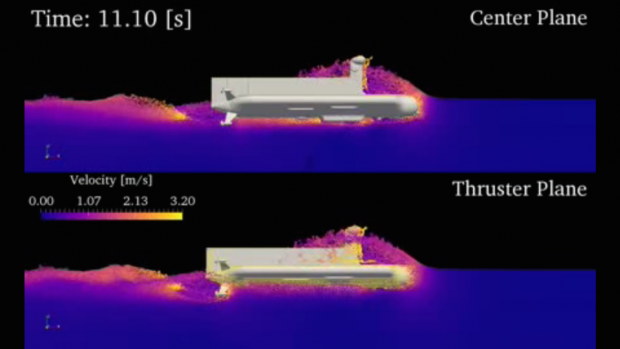NYU Tandon Lab Helps NASA Sail Smoothly on Lunar Seas

Researchers at NYU Tandon's Space and Fluids Engineering Lab are working with NASA to design a submarine meant to operate in Titan's hydrocarbon seas
From discovering a distant star, to a student-built autonomous Mars robot that mines raw materials, to alums who have gone into space, NYU Tandon School of Engineering is no stranger to being at the forefront of space exploration.
In honor of Space Day, we are highlighting an ongoing research collaboration between NYU Tandon’s Space and Fluids Laboratory (SaFE Lab) and the National Aeronautics and Space Administration (NASA) Glenn Research Center.
Tandon mechanical engineering graduate student Shane Carberry Mogan (’17) and Professors of Mechanical and Aerospace Engineering Angelo Tafuni and Iskender Sahin are assisting NASA in the conceptual design of an autonomous submarine that will navigate the liquid hydrocarbon seas of Saturn’s largest moon, Titan.
They are advising the space agency on submarine design modifications, navigation techniques, and ideal locations and depths for conducting research.
To simulate the interactions between the submarine and the extraterrestrial seas, the team is using computational fluid dynamics (CFD). “CFD analysis allows us to run simulations on various scenarios that would otherwise take very long and would be very expensive to build, construct, and test,” Mogan explains.
Computational fluid dynamics analysis is an inexpensive and efficient method to run simulations
Titan is gaining popularity among researchers because many of its morphological features are analogous to that of early-Earth. As part of its efforts to understand Titan better, NASA, in collaboration with international space agencies launched the Cassini-Huygens space mission.
A key part of the mission was to have the Cassini spacecraft successfully deliver the Huygens probe onto the surface of Titan. When the probe landed, Titan became the furthest planetary body in the solar system that man has ever landed a spacecraft on.
Both the SaFE Lab and NASA hope that their submarine will achieve another interplanetary first: be the first planetary probe in the history of mankind to ever land in extraterrestrial liquid.
Carmen Chen
NYU Tandon School of Engineering
B.S. in Chemical and Biomolecular Engineering, Class of 2017




